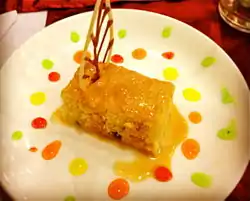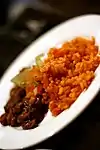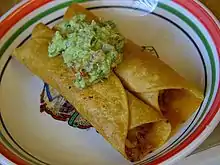 A decorated slice of tres leches cake | |
| Alternative names | Torta de tres, трилече or Trileche (Macedonian), Trileçe or trileqe (Albanian), trileçe (Turkish), leches, pan tres leches, bizcocho de tres leches, pastel de tres leches, tres leches |
|---|---|
| Type | Sponge cake (or butter cake) |
| Place of origin | Latin America |
| Region or state | Latin America, Central America, South America |
| Main ingredients | Cake base; evaporated milk, condensed milk, heavy cream |
A tres leches cake (lit. 'three-milk cake'; Spanish: pastel de tres leches, torta de tres leches or bizcocho de tres leches), dulce de tres leches,[1][2] also known as pan tres leches (lit. 'three-milk bread') or simply tres leches, is a sponge cake soaked in three kinds of milk: evaporated milk, condensed milk, and whole milk. The cake is popular throughout Latin America.
Tres leches is a very light cake, with many air bubbles. This distinct texture is why it does not have a soggy consistency, despite being soaked in a mixture of three types of milk.
Its Albanian and Turkish variety is referred to as trileçe.[3][4]
History
The dessert originated in Mexico in the 19th century.[5][6][7][8][9] It is the country's national pastry.[1]
The Austin Chronicle cited possible soaked-cake influences as English rum cake, trifle, fruitcakes, Italian zuppa inglese, tiramisu, bread pudding, and medieval Portuguese sopa dorada.[10]
Jaime Wheelock claimed that the colonization of Nicaragua, while a crisis, "gave rise to a vast process of experimentation and mixtures of food that had never before come together."[11] In the 19th century, European presence in Mexico gave way to the introduction of the antes dessert: bread soaked in wine and layered with milk custard and fruit or nuts.[10]
By 1896, the U.S. Department of Commerce was exporting condensed milk to Nicaragua.[12] Cattle, sugarcane plantations, and milk preservation techniques were introduced to Nicaragua by that time, by way of American military occupation.[11]
In 1936, president Franklin D. Roosevelt signed a trade agreement with Nicaragua, which "reduced Nicaraguan duties" in favor of importing dairy products from Wisconsin. These included evaporated, powdered, and condensed milk,[11][13] which Wheelock implies affected Nicaraguan recipes.[11] Additionally, in part due to the food insecurity of the Great Depression, canned milk sales "skyrocketed" in Nicaragua.[11]
In the 20th century in Tabasco, Mexico, a dessert named torta de leche consisted of "sweetened scalded milk, baked, and served floating in its milk sauce."[10]
Some sources refer to it as a Mexican cake.[14][15]
The dessert has since become a staple in Latin America (Mexico, Cuba, El Salvador, Venezuela, Nicaragua, Puerto Rico, Dominican Republic and Panama), and in Albania as well.[11]
Recipes for soaked-cake desserts were seen in Latin America as early as the 19th century, in countries like El Salvador, likely a result of the large cross-cultural transfer which took place between Europe and the Americas.[16] Nicaragua is one of the countries where tres leches cake has become popular.[17] The cake is popular in Central and South America, North America, and many parts of the Caribbean, Canary Islands, as well as in Albania, Serbia, North Macedonia, and some other parts of Europe.[18][19]
In the US, the cake first became popular in the 1980s beginning in Miami due to Latin American immigration. The popularity then spread across the US, possibly from Los Ranchos restaurant in Miami, which featured it on its menu when it opened in 1981. The cake was so popular from Los Ranchos, that it was featured its recipe on fliers, which were pervasively distributed. The Joy of Cooking included a tres leches recipe in its 1997 edition.[19]
European and Middle Eastern variations
A variety of tres leches known as trileçe (a caramel topped version of tres leches) became popular in the Balkans and Turkey. One theory is that the popularity of Latin American soap operas in Albania led local chefs to reverse-engineer the dessert, which then spread to Turkey.[20][21] The Albanian version is sometimes made literally with three milks: cow's, goat's and water buffalo's, though more commonly a mixture of cow's milk and cream is used. The Albanian variation “trileçe" usually has a caramel topping while the tres leches cake has a cream and fruit topping.[20]
Ingredients
Tres Leches Cake consists of a standard cake base that is soaked in three kinds of milk ("tres leches" in Spanish). The milks used in this combination are evaporated milk, condensed milk, and whole milk. This mixture is poured over a baked cake, allowing the milks to soak into the spongey cake to make a dessert with an almost pudding-like consistency.
The cake is then topped with whipped cream. Sometimes, strawberries or cinnamon is also used.
The cake base of a Tres Leches Cake can be made from scratch or by using a store-bought cake mix.[22] A yellow cake mix works well, as there are buttery flavors that complement the sweet milk mixture.
See also
References
- 1 2 Raichlen, Steven (1998). Salud Y Sazon: 200 Recetas De LA Cocina De Mama Todas Bajas En Grasa, Sal Y Colesterol! (in Spanish). Rodale. ISBN 978-0-87596-474-4.
- ↑ Raichlen, Steven (1998). Salud Y Sazon: 200 Recetas De LA Cocina De Mama Todas Bajas En Grasa, Sal Y Colesterol! (in Spanish). Rodale. ISBN 978-0-87596-474-4.
- ↑ Hoskinson, Brad. Albanian Cookbook: Traditional Recipes for The Home Cook. Brad Hoskinson.
- ↑ The Rough Guide to Europe on a Budget. Rough Guides UK. 2012-05-17. ISBN 978-1-4093-5877-0.
- ↑ Avila, Carolina (1997). Sabor!: A Guide to Tropical Fruits and Vegetables and Central American Foods. Litografía e Imprenta LIL. p. 180. ISBN 978-9977-47-226-3.
This dessert is a Costa Rican favorite. Its origin is in México, but it is savored throughout Central America and South America.
- ↑ American Bookseller. Vol. 16. Bookseller's Publishing, Incorporated. 1993.
...if you've never tried the Mexican dessert called tres leches, this is a good place to sample the moist cake.
- ↑ South Florida Folklife. Univ. Press of Mississippi. 1994-01-01. ISBN 978-1-61703-455-8.
- ↑ ISLA. Vol. 33. I.S.L.A. 1986. p. 178.
Sweet-tooths love tres leches, the thick Mexican dessert with the creamy topping and name that means "three milks."
- ↑ Petrillo, Valerie (2009-08-01). A Kid's Guide to Latino History: More than 50 Activities. Chicago Review Press. ISBN 978-1-61374-220-4.
- 1 2 3 Pack, M. M. (February 13, 2004). "Got Milk?™". www.austinchronicle.com. Retrieved 2023-04-12.
- 1 2 3 4 5 6 "The Long, Winding Origin Story of Tres Leches Cake". 17 January 2020.
- ↑ Report Upon the Commercial Relations of the United States with Foreign Countries. United States Bureau of Foreign and Domestic Commerce. 1899.
- ↑ Reciprocal trade. Agreement between the United States of America and Nicaragua. Signed at Managua, March 11, 1936 ... Executive agreement series, no. 95. Washington, D.C.: U.S. Government Printing Office. 1936.
- ↑ Foster, Lynn V.; Foster, Lawrence (1996). Fielding's Mexico. Fielding Worldwide. ISBN 978-1-56952-118-2.
- ↑ Porteé, Alex. "Why leche condensada (sweetened condensed milk) is such a staple in Latin American cooking". The Today Show. Retrieved 2023-04-11.
- ↑ Pack, MM (13 February 2004). "Got Milk? On the trail of pastel de tres leches". Austin Chronicle. Retrieved 19 January 2014.
- ↑ Stradley, Linda (2015-05-05). "Tres Leches Cake History and Recipe". What's Cooking America. Retrieved 2021-03-13.
- ↑ Higuera McMahon, Jacqueline (8 August 2007). "Tres Leches cake goes one better". San Francisco Chronicle. Retrieved 19 January 2014.
- 1 2 Galaraza, Daniela (2020-10-02). "Creamy and sweet, tres leches cake is on the rise". The Washington Post. Retrieved 2022-06-11.
- 1 2 "Trileçe kazan dünya kepçe". Hürriyet. 1 March 2015. Retrieved 13 April 2015.
- ↑ Dan Nosowitz (November 12, 2015). "How a South American Soap Opera Created a Turkish Dessert Craze". Atlas Obscura. Retrieved November 13, 2015.
- ↑ Lambert, Leslie (September 5, 2022). "Easy Tres Leches Cake With Cake Mix". Lamberts Lately. Archived from the original on May 30, 2023. Retrieved August 2, 2023.




.jpg.webp)




_01.JPG.webp)